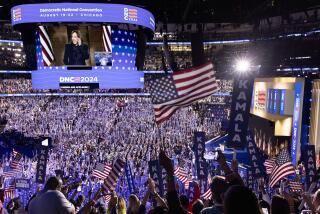Obama team trumps rambling Clint Eastwood with emotional video
- Share via
CHARLOTTE, N.C. — Clint Eastwood confirmed in an interview with his hometown newspaper that he was winging it last week when — unscripted and unvetted — he addressed the Republican National Convention.
The resulting loss for Republican presidential nominee Mitt Romney didn’t stem from what Eastwood said (an American movie icon chatting with an empty chair worked for some people), but from what the Republican presidential hopeful gave up.
Those 12 minutes of prime-time television, with an audience of 30 million people, will not be coming back, at least not too many times. The precious time could have been so much better spent, as the Democrats and President Obama proved on the last night of their convention here Thursday.
Just before Obama’s acceptance speech (time which the GOP had used a week prior for Eastwood’s unfocused ramble), the incumbent’s campaign broadcast seven minutes of highly produced, smartly edited video.
Longtime Republican political consultant Steve Schmidt, who ran John McCain’s campaign four years ago, had earlier remarked that the Democrats could not have made a stronger case for the president. And the video reinforced that contention.
Yes, the Democratic video was propaganda. But that did not stop almost all the major television outlets, including right-tilting Fox News, from showing some or all of it. Only CBS News preferred to go with commentary from its analysts, rather than content the producers at the network said they considered an advertisement.
Most television viewers at home, therefore, saw the video and a brief introduction by First Lady Michelle Obama, leading seamlessly into the president’s nomination acceptance speech.
The Eastwood intro, in contrast, had left many people buzzing about the movie actor and what exactly he had in mind with his monologue to an invisible President Obama. Was he resurrecting an old vaudeville routine?
The Democratic convention video accomplished many things — including positioning Obama as part of a legacy of leaders taking charge during tough times. Images of Pearl Harbor, the Great Depression, the Twin Towers after Sept. 11 melded with shots of the Wall Street panic of 2008 and the long job lines that have followed.
George Clooney provided the voice over and testimonials came from three top surrogates — Michelle Obama, Vice President Joe Biden and former President Bill Clinton.
Michelle Obama told how her husband is up until 1 or 2 a.m. each night, studying briefing books and reading letters from the American people. Clinton described how Obama went after healthcare reform, knowing the “horrible consequences” politically, because he wanted to lift the heavy burden of high medical bills from average people. Biden talked about the president’s “ramrod spine” in making the call to send Navy SEALs after Osama bin Laden, when some of his advisors weren’t sure.
The piece reached an emotional crescendo with Clooney — speaking over pictures of hard working Americans — talking about how we have all endured tough times together.
“We have a long way to go,” the actor said, “but with every new beginning, every homecoming, every step forward, we remember who we are.” Obama ended the video describing the “incredible gift” he gets, every day, working for the American people.
The unmistakable, but unspoken, message to the more than 35 million people who tuned in during the prime-time television hour: “You can’t let me go now; we’ve been through so much together. And things are going to get better any day now.”
Romney’s team also produced a slick, winning video, not terribly unlike the one by Obama’s handlers. The difference: it played out of prime time and went unseen by most Americans.Team Romney, instead, offered up an ornery Eastwood, playing himself, and connecting most deeply with an empty seat.
More to Read
Get the L.A. Times Politics newsletter
Deeply reported insights into legislation, politics and policy from Sacramento, Washington and beyond. In your inbox three times per week.
You may occasionally receive promotional content from the Los Angeles Times.











